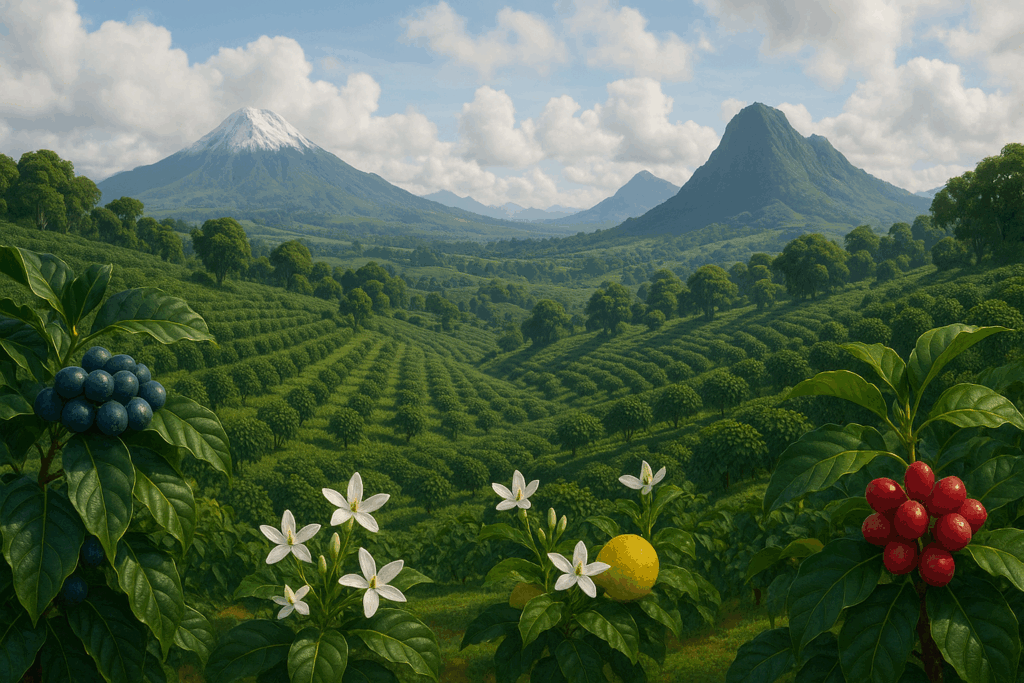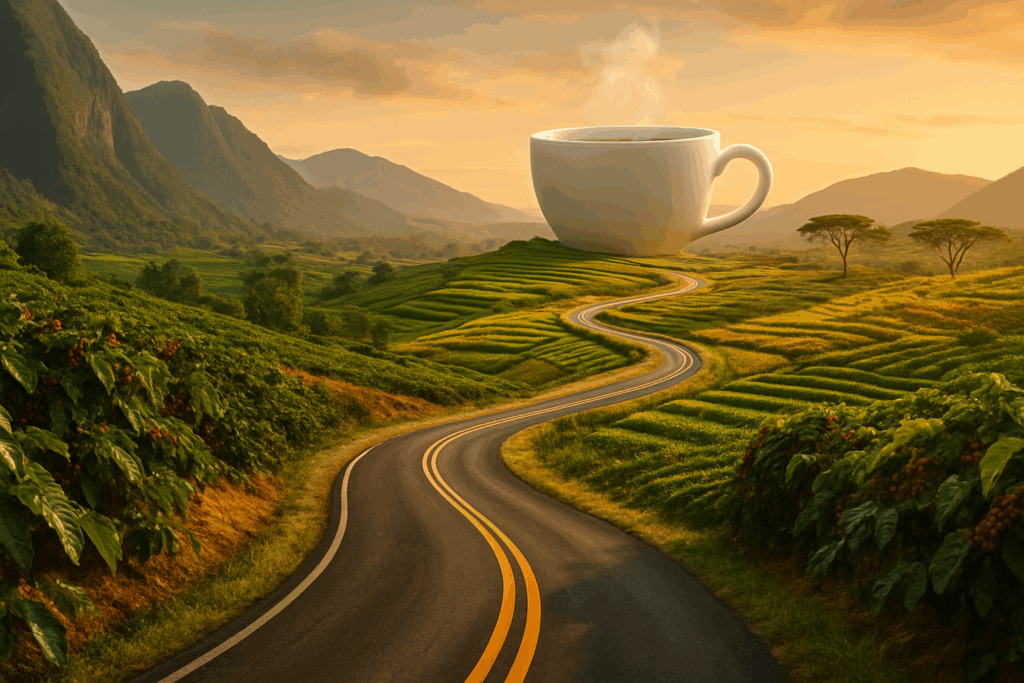Coffee Belt Countries: How Origin Shapes the Flavor in Your Cup
Why does coffee from Kenya burst with juicy berry notes, while beans from Brazil taste like a bite of your favorite chocolate bar? It’s not magic – it’s geography with a flavor twist. Tucked close to the equator is a vibrant, coffee-growing belt where every great bean gets its start. This isn’t just a fun detail to overlook. It’s the invisible thread connecting your morning brew to distant lands – the reason your coffee can surprise you with berries one day and warm you with roasted nuts the next. Once you see how place turns into flavor, your coffee routine transforms from habit into exploration. Suddenly, you’re not just drinking coffee. You’re tasting the world – one origin, one story, one sip at a time.
What Is the Coffee Belt (and Why It’s Worth Knowing)?
The coffee belt is a narrow yet powerful stretch of land that winds across the middle of the globe, spanning approximately between 23.5° north and 23.5° south of the equator – the latitudes marked by the Tropic of Cancer and the Tropic of Capricorn. It winds its way through Central and South America, across Africa, and into Asia-Pacific – and it’s where over 99% of the world’s coffee is born. Why this zone? Because it’s nature’s sweet spot. These regions offer ideal growing conditions: warm days, cool nights, rich volcanic or loamy soils, consistent rainfall, and high elevations. In this climate, coffee cherries ripen slowly, absorbing complexity and developing the deep, nuanced flavors we crave.
But here’s what makes the coffee belt truly fascinating: while it may be one geographic band, it’s home to countless flavor expressions. Each country—and often even each micro-region—leaves a distinct mark on the coffee it produces. From the floral brightness of high-grown Ethiopian beans to the mellow sweetness of a Brazilian roast, origin shapes every sip. Soil chemistry, altitude, processing methods, and local tradition all leave their mark. In that sense, the coffee belt isn’t just a place. It’s a global tasting tour. Not about becoming an expert. It’s about understanding your own taste preferences and where they come from. Once you start connecting geography to flavor, every cup becomes a little more exciting.
Latin America: The Comforting Side of the Coffee Belt
From the lush highlands of Colombia to the sun-drenched savannas of Brazil, Latin America produces coffees that have become global favorites for a reason. Here, beans often deliver notes of chocolate, toasted nuts, caramel, and ripe fruit. The overall profile? Comforting, smooth, and beautifully balanced – the kind of coffee that feels instantly familiar, even on the first sip.
These coffees tend to have medium body and acidity, making them accessible without ever being dull. Guatemala might charm you with floral honey sweetness, while a Colombian classic brings together citrus brightness and cocoa depth. It’s a region made for those who want coffee that soothes and satisfies in equal measure. Latin America is the heart of approachable coffee—welcoming, balanced, and full of comfort with every sip.

Africa: Where Coffee Turns Bright, Fruity, and Floral
Africa is the birthplace of coffee, and its legacy still pulses through every cup grown in its rich, diverse landscapes. From the misty mountains of Ethiopia to the sunlit slopes of Kenya and Tanzania, this region produces beans bursting with life. Expect vibrant acidity, fragrant floral notes, and a wide range of bright fruit flavors – blueberry, lemon, jasmine, even hints of red wine. The profiles are anything but predictable, making each sip a small revelation.
What makes African coffee even more intriguing is the altitude and precision behind it. Many of these beans are grown high above sea level and processed using methods that preserve their vivid clarity and aromatic depth. Washed Ethiopian Yirgacheffe coffee, grown high in the mountains, is known for its clean and floral taste. It can remind you of Earl Grey tea – a black tea flavored with bergamot, a citrus fruit that gives the tea its floral, lemony aroma and taste. Yirgacheffe is a region in Ethiopia that’s famous for producing delicate, tea-like coffees that many coffee lovers admire.
Kenya AA, on the other hand, refers to a grade of coffee made from Kenya’s biggest and highest-quality beans. These beans are grown at high altitudes and often taste like tart berries or sweet stone fruits. If you enjoy bright, complex, and fruity coffee, the African region offers some of the most exciting flavors in the world.

Asia-Pacific: Rich, Spiced, and Boldly Different
If Latin America is comfort and Africa is brightness, then Asia-Pacific is the region of richness and mystery. From the jungles of Indonesia to the volcanic soils of Papua New Guinea and the windswept coasts of India, this part of the coffee belt is home to bold, earthy flavors. These coffees tend to embrace a darker profile, with low acidity and a heavy body. Expect flavor notes like dark chocolate, clove, cedarwood, or even a hint of tobacco.Each cup feels grounding, like it wants you to slow down and savor.
What makes these coffees truly unique isn’t just the geography – it’s the way they’re processed. Sumatran beans often go through a method called wet-hulling, which boosts body and adds a bold, slightly earthy edge. Indian Monsooned Malabar stands out as a unique coffee aged during India’s monsoon season. Producers store the beans in open warehouses, where humid air makes them swell, reduces their acidity, and brings out a mellow, smoky flavor. These coffees shine in slower brew methods like French press or moka pot, perfect for drinkers who enjoy a bold, warming cup with real depth. If you enjoy coffee that’s rich and full of unexpected depth, this region could become your new favorite.

Why the Coffee Belt Is the Key to Flavor
You don’t need to be a coffee connoisseur or memorize endless origin names to enjoy truly great coffee. All it takes is a basic understanding of the coffee belt – the regions where your beans come to life. Once you grasp how origin shapes flavor, you’ll find yourself making better choices at the store, experimenting more at home, and getting far more joy from every cup.
Each region has a personality all its own. Latin American coffees are often smooth, balanced, and full of cozy cocoa and nutty notes. African beans tend to burst with fruitiness, floral aromas, and lively acidity. And Asia-Pacific coffees? Think earthy, spiced, and rich – perfect for those who love depth and bold character. Understanding these differences is like learning the accent of each coffee – suddenly, your morning brew speaks your language.
The Coffee Belt Isn’t Just a Place – It’s a Path
Behind every cup of coffee is a living landscape: soil enriched by volcanoes, misty mornings on remote hillsides, and hands that carefully pick each cherry. The coffee belt isn’t just a place on the map – it’s the source of every flavor nuance, from the brightness of African citrus to the richness of Indonesian spice. It’s where geography, culture, and craft come together to shape the character of your brew.
Understanding the coffee belt doesn’t require expertise – just curiosity. Because once you know where your coffee comes from and why it tastes the way it does, the act of brewing becomes something more. A ritual. A connection. And maybe even a little adventure in your cup. Every sip becomes a step on a journey that begins far away, but ends right where you are.


